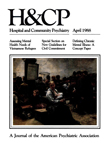Variations in Seclusion and Restraint Practices by Hospital Location
Abstract
Data from a survey of seclusion and restraint practices in New York state hospitals were analyzed to determine if they differed by hospital location. The study included 19 hospitals—five in New York City, four in New York City suburbs, three in large towns, and seven in small towns. Overall, New York City and large-town hospitals had the highest rates of seclusion and restraint, but analysis by age group showed that New York City had the lowest rate for patients under age 35, who constituted the majority of patients who were secluded or restrained, and large towns had the highest rate. compared with suburban and small-town hospitals, city and large-town hospitals used seclusion more often than restraint and had a higher ward census and a lower-staff patient ratio. In all groups males and blacks were overrepresented compared with the hospital population. The authors believe clarification of regional variations in assaultive behavior is important for treatment and system planning.
Access content
To read the fulltext, please use one of the options below to sign in or purchase access.- Personal login
- Institutional Login
- Sign in via OpenAthens
- Register for access
-
Please login/register if you wish to pair your device and check access availability.
Not a subscriber?
PsychiatryOnline subscription options offer access to the DSM-5 library, books, journals, CME, and patient resources. This all-in-one virtual library provides psychiatrists and mental health professionals with key resources for diagnosis, treatment, research, and professional development.
Need more help? PsychiatryOnline Customer Service may be reached by emailing [email protected] or by calling 800-368-5777 (in the U.S.) or 703-907-7322 (outside the U.S.).



